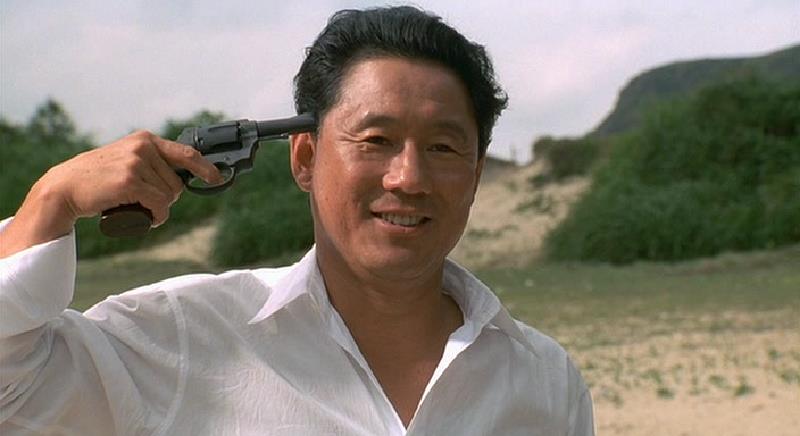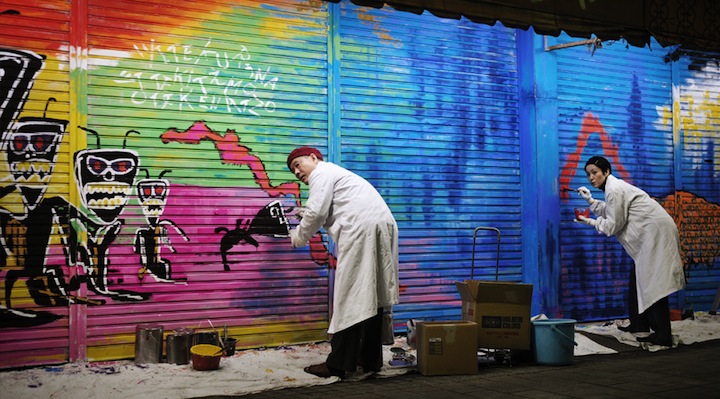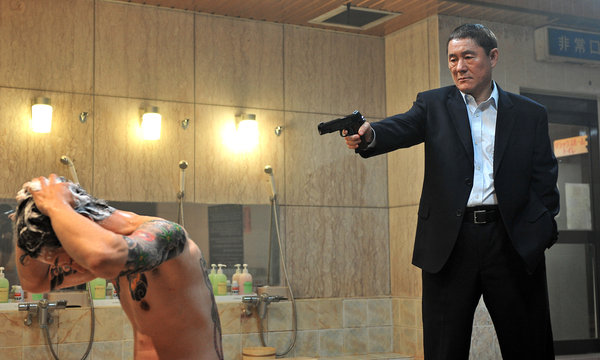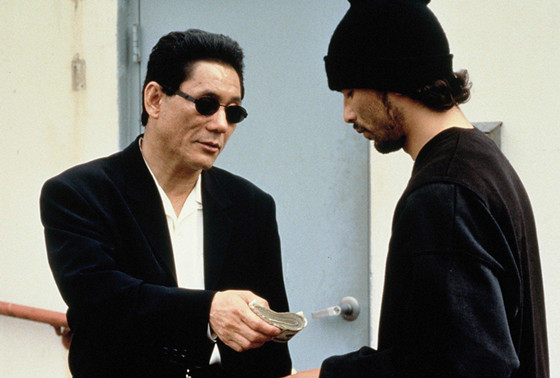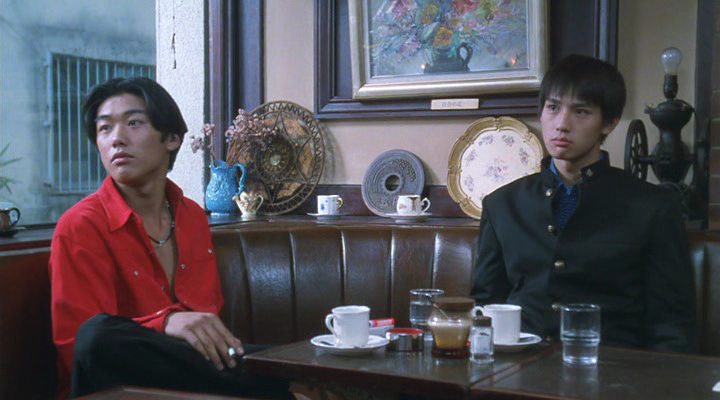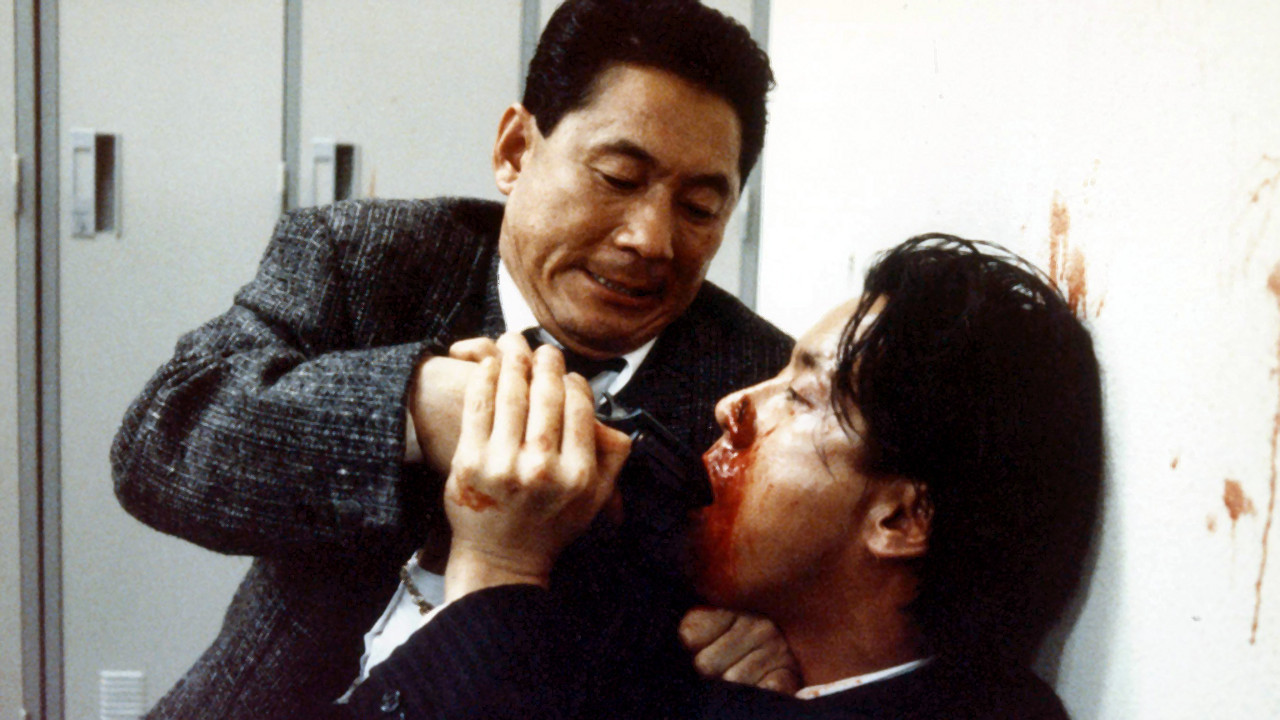One of the foremost prolific artists and individuals in his field, Takeshi Kitano has established himself as a global star and one of the most celebrated persons in his native Japan, He is a director, actor, film editor, screenwriter, show host, presenter, author, poet, painter, video game designer, entrepreneur and professor of visual arts.
He’s owned his own talent agency and production company, Office Kitano, since 2000. His films, both the ones he directed and the ones he acted in, have netted him awards in festivals all over the world and are overwhelmingly internationally acclaimed. Here are his 10 best films in his former capacity.
10. Achilles and the Tortoise (2008)
The third and final installment of Kitano’s surrealist autobiographical trilogy heralded his return to quality films, since the other two films, “Takeshis” and “Glory to the Filmmaker” were disappointing, if not outright failures. The title is based on one of the ancient Greek Zeno’s paradoxes, whose purpose was to undermine common sense.
Machisu is the only child of an upscale art collector, who gave him his love for art. When a famous artist and friend of his father pays young Machise a compliment, the boy is inspired to become a painter. He starts painting everyday and everywhere, even during his classes at school. Unfortunately, his father commits suicide and Machisu ends up in an orphanage.
In the second timeline of the film, we discover Machisu working to pay his tuition to the art school he attends, and later marrying his co-worker, Sachiko, played by Kumiko Aso.
In the third timeline, the middle-aged Machisu, played now by Beat Takeshi (the pseudonym Kitano uses as an actor) has become completely smitten with art, completely unconscious to the people around him and the world in general.
Kitano directs a film about the world of modern art, stating that almost all of the contemporary artists have misinterpreted artistic value and creativity with fame and commercial success.
“Achilles and the Tortoise” is almost as confusing and incoherent as the other two parts of the trilogy, but it differs due to the first two timelines, which are actually funny and accessible to the audience. The third timeline, however, is nothing but a series of comical sketches disconnected with each other and the rest of the movie.
9. Outrage (2010)
“Outrage” marked Kitano’s comeback to violent Yakuza films, the genre that set him off as a world-class filmmaker, and a trend that brought a sequel, “Beyond Outrage”.
Beat Takeshi plays Otomo, a Yakuza member who is tasked with bringing a rival gang in line. The film is crammed with the specifics of the genre: betrayals and cross betrayals, revenge, matters of hierarchy, politics, plenty of sociopathic characters, excessive violence and constant deaths. The film also has Kitano’s hypodermic humor that seems to lurk in places that no one would expect, such as the torture scenes with the box cutter and the dentist drill.
With that said, after awhile “Outrage” settles into a continuum of beatings and deaths, and it becomes difficult to follow the alliances and their breaking, to the point where the audience cannot sympathize or even get to know a character because he is almost instantly killed, with the sole exception of Otomo.
Due to the aforementioned factors, the film could be interpreted as a parody of the genre, while Kitano seems to stress the fact that the Yakuza world is outdated, hinting perhaps that the same thing applies to the whole film genre.
The strongest aspect of “Outrage” is the technical elements, where the cinematography and the action choreography truly excel.
8. Brother (2000)
“Brother” is Kitano’s first and last movie filmed outside of Japan. It was shot mostly in Los Angeles, and it presented him with a variety of issues and things he despised, such as heavy censorship, that resulted in an outcome he was not fully satisfied with. This consequentially made him decide not to work outside Japan again.
Beat Takeshi plays Yamamoto, a Yakuza that flees Japan due to a gang war that started when his boss was murdered. He arrives in Los Angeles, where his half brother Ken and his partner, Danny are running a small time drug business. Together with his facilitation, which features a number of bloodbaths and the addition of former comrades in the gang, the drug business prospers, particularly once the “Boss of Little Tokyo” and his gang also join them.
“Brother” writhes with violence from beginning to end, with a number of memorable scenes of Kitano’s filmography. His first meeting with Danny, the scene with the chopsticks, the meeting with the rival gang and some graphically shown hara-kiri, are just a few of the rough scenes spectators encounter.
Also present is his unique sense of humor. The dice game, his girlfriend, the scene with the African-American who wants to sell his bike for food and most of all, the basketball scene are as funny as they are perverse.
One of his familiar concepts, the “only man left on earth” is present here, with his character being so distanced that he hardly speaks, although that is a necessity as well as a style choice, since Kitano is quite uncomfortable with the English language.
Susumu Terajima, one of his regulars, gives an excellent performance, with his equally violent and comic acting.
7. Kids Return (1996)
This is Kitano’s first film that was a success in his native country, since up to that point, Japanese viewers were far less captivated with his films than with international ones.
“Kids Return” also marks a milestone in Kitano’s life. Shortly before the film was set to shoot, he had an accident driving his scooter while intoxicated, which led to a month in intensive care, an open skull fracture, brain contusions and a fractured cheekbone. Though he would never admit it, the accident changed him: He curtailed on drinking and smoking and took up painting.
After exiting the hospital he gave a press conference, where he admitted that for years he was under extreme pressure, which caused him to be stress to the point of becoming suicidal and self destructive, which in its own accord led to alcoholism.
During the press conference, Kitano was suffering from paralysis in the right side of his face, missing parts of his cheekbone, and he could barely speak, resulting in speculations that he may never act or direct again. He proved them all wrong by acting in “Gonin” almost immediately afterward, and after that directing, scripting and editing “Kids Return”.
Based on the homonymous, autobiographical book by Kitano, “Kids Return” tells the story of two high school delinquents, Masaru and Shinji, who spent their time playing pranks, bullying classmates and sneaking into movies. When Masaru gets beaten up, he takes up boxing and shortly after convinces Shinji to follow him.
Shinji gets better and better at it, something that does not appeal to Masaru, who quits boxing and school and joins Yakuza. The progress of the two parallel each other, with Shinji rapidly progressing in boxing and Masaru moving up through Yakuza, although they grow further and further apart.
Some of Kitano’s most popular themes are present here: Male friendship, morality and of course, Yakuza and its politics. Also present is a clear message regarding the failure of conservative Japanese society to produce motives and a sense of belonging and direction to youths, who do not wish to or can’t follow the traditional path of education that leads to professional reintegration.
Kitano has stated about the movie, “I wanted to show how mediocrity will always succeed in Japanese society. If you don’t go against the rules, if you go with the flow, you will achieve a certain level of success, an easy living.”
Taking the three aforementioned roles for himself, Kitano is in total control of the flow and narrative of the film, showing off his distinctive filmmaking style, consisting of scarce dialogue, lots of random flashbacks, and long, static shots.
“Kids Return” won a number of awards in Japan, mainly for Masanobu Ando who made his debut as Shinji. Kitano also netted a couple of awards for his direction.
6. Violent Cop (1989)
Kitano’s directorial debut, “Violent Cop” also has a noteworthy story behind its creation. Kinji Fukasaku was originally slated to direct, Kitano was cast as the main lead, and the movie was purported to be a comedy.
When Kitano informed the producers that he would only be available for a specific amount of time due to his heavy TV schedule, and that he intended on doing only one rehearsal and one take, Fukasaku refused to work under these conditions and presented a “him or me” dilemma to the producers.
The initial response was to drop the project altogether, until Kitano proposed to direct the movie, and the producers accepted. Subsequently, Kitano went on revising the whole script, transforming it from a comedy to a dark, violent police drama.
Kitano plays Azuma, a violent cop, who also has to take care of his sick sister, Akari. When a drug dealer is found murdered, he discovers the involvement of his colleague and friend, Iwaki, who commits suicide shortly after, due to the disclosure. After awhile, Azuma learns that Kiyohiro, a Yakuza, had something to do with Iwaki’s death and arrests him; however, his men abduct Akari. Azuma then decides to free her on his own, turning into a person wholly oblivious to the law and any kind of ethical perspective.
Kitano creates a hero, much like a Clint Eastwood character, who is the only one who understands that in order to confront contemporary criminals, you have to be at least as violent and cruel as they are. After a point though, the boundary between the two becomes invisible.
Many aspects that later became known in Kitano’s filmmaking style can be found in “Violent Cop”: the Yakuza theme, the extreme violence, the concept of “one against the world”, the anti-hero lead, the scarce dialogue, the long master shots, and the restraint acting, all have their roots in this particular movie.
Most audiences received “Violent Cop” poorly; however, Kitano received two Japanese awards for his direction, from Nikkan Sports and the Yokohama Film Festival.
